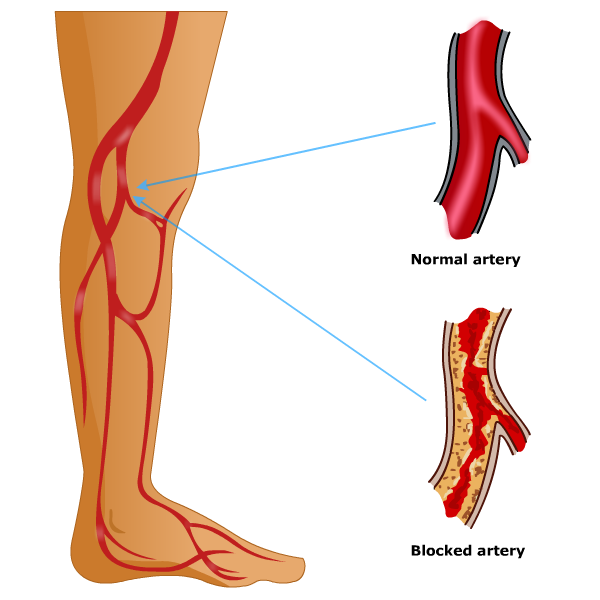
Peripheral Artery Disease
When leg arteries become narrowed or blocked by plaque it causes peripheral Arterial Disease (PAD), a condition that raises the risk of heart attack, stroke, leg amputation and death. As patients are unaware of this condition generally, PAD remains under-diagnosed and under-treated. In PAD, characteristically, there is a reduction in blood flow to the lower extremities due to plaque build-up in the leg arteries (also known as atherosclerosis). A combination of fats, cholesterol and other substances constitutes plaque. Size of plaque can grow to significantly reduce blood flow through an artery.
Blood flow to the legs and feet is reduced when leg arteries are hardened and clogged. Peripheral arteries remain blocked, completely or partially, and cause pain, changes in skin color and temperature, sores or ulcers and difficulty walking. PAD, if left untreated, can lead to Critical Limb Ischemia (CLI), a condition where not enough blood is being delivered to the leg to keep the tissue alive. Gangrene ensues due to total loss of circulation to the legs and feet leading to amputation. Hardened arteries, in addition, found in people with PAD are a sign that they are likely to have hardened and narrowed arteries to the heart and the brain. That is why people with PAD are at high risk of having a heart attack or a stroke. They may become disabled and not be able to go to work, with poor quality of life.
9,600+
Happy Patients
10
Qualified Doctors
500+
Successful Surgeries
100+
Insurance Partners
PAD is a chronic disease with risk factors that include:
Smokers or people with diabetes have the greatest risk of developing peripheral artery disease due to reduced blood flow.
Atherosclerosis is the main cause of peripheral artery disease. Fatty deposits (plaques) build up in your artery walls and reduce blood flow in atherosclerosis. This disease can and usually does affect arteries throughout your body although the heart is usually the focus of discussion of atherosclerosis. Atherosclerosis in the arteries supplying blood to your limbs causes peripheral artery disease. The cause of peripheral artery disease, less commonly, may be blood vessel inflammation, injury to your limbs, unusual anatomy of your ligaments or muscles, or radiation exposure.
Generally, most people with peripheral artery disease have mild or no symptoms. Some people have leg pain when walking (intermittent claudication). The symptoms of intermittent claudication include muscle pain or cramping in your legs or arms that are triggered by activity, such as walking but disappears after a few minutes of rest. Pain is localized to the area supplied by the clogged or narrowed artery. Pain in the calf is the most common location.
There is a wide variation in the severity of intermittent claudication, ranging from mild discomfort to debilitating pain. Walk or doing other types of physical activity could be a hard task due to severe intermittent claudication.
Other symptoms of peripheral artery disease include:
Progression of peripheral artery disease can lead to pain that may even occur when you’re at rest or when you’re lying down (ischemic rest pain). Its intensity could be strong enough to disrupt sleep. Temporary relief could be obtained by hanging your legs over the edge of your bed or walking around your room.
Progression of peripheral artery disease can lead to pain that may even occur when you’re at rest or when you’re lying down (ischemic rest pain). Its intensity could be strong enough to disrupt sleep. Temporary relief could be obtained by hanging your legs over the edge of your bed or walking around your room.
Plaque buildup in blood vessels leading to peripheral artery disease (atherosclerosis) leads to a risk of developing:
There are two major goals of treatment for peripheral artery disease. Managing symptoms, such as leg pain, so that you can resume physical activities is the primary goal. To stop the progression of atherosclerosis throughout your body to reduce your risk of heart attack and stroke is the secondary goal.
These goals can be accomplished with lifestyle changes. Quitting the smoking habit is the single most important thing you can do to reduce your risk of complications. You need additional medical treatment if lifestyle changes are not enough. Your doctor may prescribe medicine to prevent blood clots, lower blood pressure and cholesterol, and control pain and other symptoms.
Medications are required if lifestyle changes alone don’t help your angina. Medications may include:
Angioplasty and surgery
In extreme cases, angioplasty or surgery may be necessary to treat peripheral artery disease that’s causing intermittent claudication:
Lifestyle Measures
The symptoms of peripheral artery disease can be managed effectively with lifestyle measures and the progression of the disease can be slowed, especially by quitting smoking. To stabilize or improve PAD:
Careful foot care
Care of the feet is very important in addition to the above suggestions. Follow this advice to care for your feet:
Prevention
Maintain a healthy lifestyle to prevent claudication. That means: